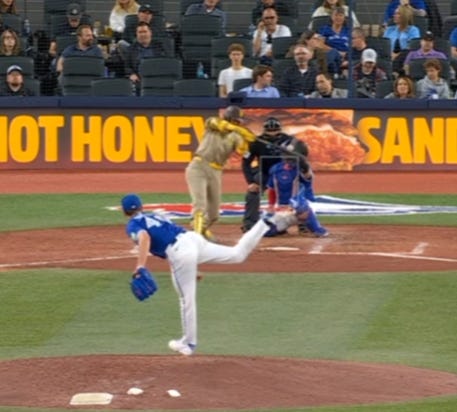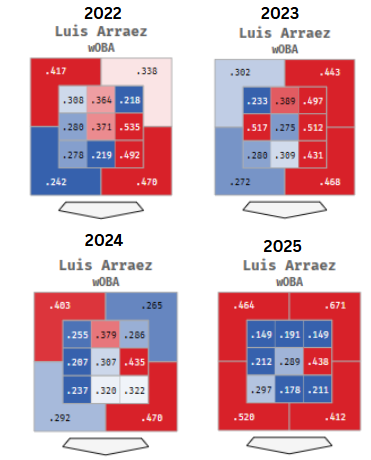Luis Arraez took an at bat in the 6th inning Tuesday that is worth taking a closer look at. Here is the pitch sequence:
This is the gameday breakdown of the pitch locations:
These swing decisions are a problem. It’s not just that these pitches aren’t the best pitches to hit1. Even for hitters who can do damage on these pitches, it is a poor decision to swing in this context. Here’s why: In the at bat above Arraez is leading off the 6th inning, which means there are no runners on and no outs. Just like there are times when avoiding a strike out is disproportionately valuable, there are times when being willing to take a strikeout can be very valuable. When there are no runners on base the value of a single is exactly the same as a walk. And although Arraez is not totally devoid of power (he has a 6.3% extra base hit rate) the vast majority of his hits are singles. Once the count reached 3-2 Arraez swung at four straight pitches out of the strike zone. Perhaps you can give him a pass for swinging at the 6th pitch of the at bat which had spin. But the 7th, 8th, and 9th pitches of the at bat were fastballs out of the zone:



And you might think since these are close pitches he has to protect the plate. But in this game situation that line of reasoning is flawed. Because even if these pitches had a 50/50 shot of being called strike three, that’s still a very very good gamble for a singles hitter to take with the bases empty. If you’re following the math here you understand that taking any of these pitches is going to carry at least a .500 on base percentage (50% chance it’s strike three, 50% chance it’s ball four2). So the opportunity cost of swinging is a .500 on base percentage. Irrespective of the outcome of the swing, you’re incurring an opportunity cost by foregoing the possibility of a .500 OBP by simply taking the pitch.
Arraez is a very good hitter when he expands the zone:
But the point here is that there are certain situations where even if you’re a good hitter when expanding the zone, the outcome of the at bat is more likely to be productive by taking the 50/50 strike three/ball four gamble.
In an interesting coincidence the broadcast during this at bat included a segment from Mike Pomeranz on the advice Padres hitting coach Victor Rodriguez has tried to impart on Luis Arraez about these situations:
This is impeccable situational hitting guidance from Rodriguez, though it’s understated. Arraez shouldn’t be a ‘skosh’ more selective in these situations. He should be much more selective when no one is on base. And once the count reaches 3-2 he should be extremely selective. Because even though taking a close pitch might lead to a strikeout rate of 50%, a mark that would make even Joey Gallo blush, that risk is still very worthwhile because of the 50% chance at a walk which is more productive than the expected outcome of a swing. When the vast majority of your hits are singles, and the bases are empty, simply taking a close 3-2 pitch is functionally the same as batting .500.
Arraez hits in front of two of the best power hitters in the lineup. And while they’ve been out of sorts the past four games, they won’t be forever. When Arraez is leading off an inning in front of those two the goal needs to be maximizing the chances of getting on base. Victor Rodriguez understands this, and he’s advised Arraez on this in the past. It may be time for a reminder.
The Padres scoring famine continued Tuesday. They’re 0 for 24 with runners in scoring position since the start of the Mariners series, and they’ve struck out a horrid 40% of the time in those at bats. But while they’re unquestionably striking out too much during those at bats, there are other at bats during the first game in Toronto that suggest at least in some at bats they’re not striking out enough.
Arraez is generally very good at hitting pitches out of the strike zone, but there’s reason to think this year could be different. We will write about this in part 2.
These pitches were far enough out of the zone that they were probably closer to 70-30 to be called a ball, but the point here is that even the least favorable odds conceivable still imply that a take is a good decision.




Had this discussion a lot with a friend when Soto was here. A guy like Soto should be less selective, especially 3-2,since he can do real damage on balls out of the zone. He’s going to hit for doubles and home runs on some of those. Game context matters of course but the general proposition applies.
"If you’re following the math here you understand that taking any of these pitches is going to carry at least a .500 on base percentage (50% chance it’s strike three, 50% chance it’s ball four2)"
Not to quibble, but that's a .500 on base PROBABILITY. It's going to create either a 0 of 100 on base percentage.